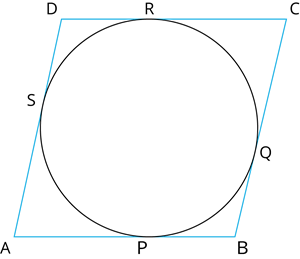Show that the parallelogram circumscribing a circle is a rhombus.
Proof:
Let \(ABCD\) is a parallelogram and let \(P, Q, R\) and \(S\) be the point of contact of circle and parallelogram.

We know that, the lengths of tangents drawn from an external point to a circle are equal.
\(AP = \) ----(1)
\(BP = \) ----(2)
\(CR = \) -----(3)
\(DR = \) -----(4)
By, adding (1), (2), (3) and (4) RHS = LHS, we get
\(AP + BP + CR + DR = AS + BQ + CQ + DS (AP + BP) + (CR + DR)\)
\(= (AS + DS) + (BQ + CQ)\)
\(AB + CD = AD + BC\)
As \(ABCD\) is a , \(AB = CD\) and \(AD = BC\)
Hence, \(2 AB = 2 \)
\(AB = BC\)
If adjacent side of parallelogram are equal, then it is a rhombus.
Hence, \(ABCD\) is a rhombus.